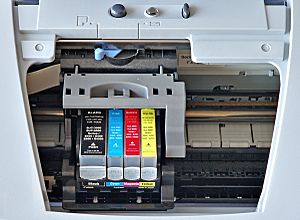Primary color facts for kids
Primary colors are special sets of colors that can be mixed together to create a wide range of other colors. Think of them as the basic building blocks of color. The cool thing about primary colors is that you can't make them by mixing other colors. They are "pure" in their own way.
There are two main ways we talk about primary colors:
- Subtractive colors: These are used when you mix things like paints, inks, or dyes. The most common subtractive primaries are cyan, magenta, and yellow. Artists often use red, yellow, and blue.
- Additive colors: These are used when you mix lights, like on a TV screen or when you shine different colored spotlights. The main additive primaries are red, green, and blue.
Contents
How Our Eyes See Colors
Primary colors aren't just a random idea; they're linked to how our eyes work! Our eyes have tiny cells called cone cells that help us see color. Most humans have three types of these cone cells. Each type is sensitive to different ranges of light wavelengths. Because we have three types of cones, humans are called trichromats (meaning "three colors"). This is why we usually talk about three primary colors.
Light itself is a continuous spectrum of colors, but our eyes simplify it into these three main signals.
Additive Primary Colors (Mixing Lights)
When you combine different colored lights, you're using the additive color system. The best example of this is your TV or computer screen. These screens create all their colors by mixing tiny dots of light.
The additive primaries are red, green, and blue. These colors are chosen because they allow us to create the largest range of colors that human eyes can see.
Here's how they mix:
- Red light + Green light = Yellow or orange
- Green light + Blue light = Cyan
- Red light + Blue light = Purple or magenta
If you mix equal amounts of all three additive primaries (red, green, and blue) at full brightness, you get white light! If you mix them at lower brightness, you get different shades of grey. This system creates what's called the RGB (Red, Green, Blue) color space.
Subtractive Primary Colors (Mixing Paints and Inks)
When you mix paints, inks, or dyes, you're using the subtractive color system. This is how printers work. These materials absorb (or "subtract") certain colors of light and reflect others. This is why the surface you're printing on, like paper, works best when it's white. White paper reflects all colors, allowing the inks to show their true colors.
The subtractive primaries used in printing are yellow, cyan, and magenta.
Here's how they mix:
- Yellow + Cyan = Green
- Yellow + Magenta = Red
- Magenta + Cyan = Blue
In theory, if you mix equal amounts of all three subtractive primaries, you should get black. However, in real life, mixing these pigments often creates a muddy brown color instead of a true black. That's why printers usually add a fourth "primary" color: black ink. This is why the system is called CMYK (Cyan, Magenta, Yellow, and Black). The 'K' stands for "Key" or "Kohle," which is German for coal, used to represent black so it's not confused with blue.
Mixing real paints can be a bit tricky. Sometimes, adding white paint to a color can slightly change its hue, not just make it lighter. For example, adding white to red might make it look a little bluish, creating a pink shade.
Images for kids
-
A close-up photo of the red, green, and blue dots (subpixels) on an LCD screen. Mixing the light from these colored dots creates realistic images.
-
Ewald Hering's drawing of how our brains process colors. Red and green, and yellow and blue, are seen as "opponent" pairs.
-
Johann Heinrich Lambert's "Color Pyramid" from 1772, showing how yellow, red, and blue pigments mix with white to create different shades.
-
Philipp Otto Runge's drawing showing blue, yellow, and red as the main colors.
See also
 In Spanish: Color primario para niños
In Spanish: Color primario para niños











